CHKDSK is a command-line utility on Windows that scans a disk’s file system for logical errors and repairs them. It is commonly used when a disk behaves abnormally or as a precautionary measure.
However, some users encounter the “CHKDSK cannot open volume for direct access” error when trying to run the CHKDSK command. In this case, they can neither access their files nor repair the drive, which can be extremely frustrating. Here is an example:
My USB drive is not showing in this PC, but it is showing in Disk Management as removable media. I tried doing CHKDSK on it, but it showed the “CHKDSK cannot open volume for direct access” error. How do I recover my files and repair my USB drive?reddit.com

So, I wrote this guide to explain why this error occurs and how you can fix the drive without losing data. Keep reading.
What Does “CHKDSK Cannot Open Volume for Direct Access” Mean
This “CHKDSK cannot open volume for direct access” error occurs when CHKDSK tries to read the disk but is blocked from accessing it. In other words, CHKDSK cannot gain direct access to the volume.
This error can be caused by several factors:
- Disk in use. The disk may be locked by the system or other software. Conflicts with some services or drivers can also prevent CHKDSK from accessing the drive.
- File system corruption. The disk’s file system metadata may be damaged, preventing CHKDSK from mounting or scanning the volume.
- Hardware failures. There are bad sectors or physical failures on the disk, making the disk unreadable.
Faced with this error, try the following methods to fix it.
Basic Checks: Restart the PC or Try Another Computer
Sometimes, CHKDSK cannot access your disk simply because the system or other programs are temporarily using it. So, restarting the computer can release the lock on the disk and allow CHKDSK to run.
If the error persists after restarting the computer, try connecting it to another computer or device (if possible). This can help determine whether the problem is related to your current system configuration or the disk itself.
If the basic troubleshooting steps fail, proceed with the following advanced solutions.
Fix 1. Use Chkntfs to Bypass Volume Lock
Chkntfs is a Windows command-line utility that controls whether a disk is checked at startup. By adding the /X switch, you can prevent a specific drive from being checked at startup.
Why does this work? Sometimes, an automatically scheduled CHKDSK or another program may lock the volume, preventing CHKDSK from accessing the disk. Running the chkntfs /X command releases this lock, allowing CHKDSK to run.
Many users have reported that this method is effective. So, follow the steps below to try it out.
Step 1. Type cmd in the Windows search box. When the Command Prompt option appears, right-click it and click Run as administrator.
Step 2. If the User Account Control window shows up, select Yes to continue.
Step 3. Type chkntfs /X drive letter: and press Enter.
Replace the drive letter with the actual letter of the problematic drive. For example, to scan the H: drive, input chkntfs /X H: and hit Enter.
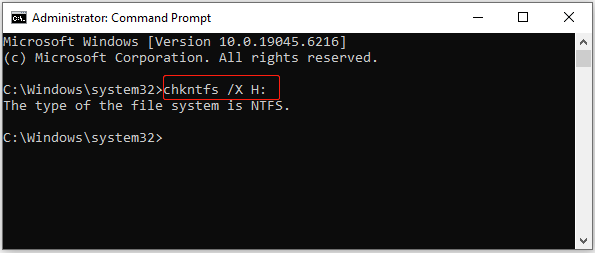
Step 4. Now you can reuse the CHKDSK command to scan your drive for file system errors and repair them.
Fix 2. Run CHKDSK in a Clean Boot Environment
A clean boot starts Windows with a minimal set of drivers and startup programs. It is a special mode used to identify if software conflicts are preventing CHKDSK from running.
Here is how to perform a clean boot:
Step 1. Press Windows + R to open Run. Then type msconfig and press Enter.
Step 2. In the System Configuration window, go to the Services tab.
Step 3. Tick the checkbox of Hide all Microsoft services. Then click Disable all to disable the remaining non-Microsoft services.
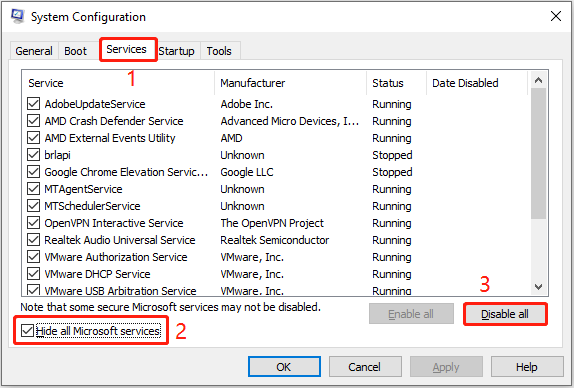
Step 4. Go to the Startup tab, and click Open Task Manager.
Step 5. For each unnecessary enabled item, select it and hit Disable.
Now you can restart your computer and check if CHKDSK can run without errors.
- If CHKDSK still fails, move on to the next solution.
- If CHKDSK runs well in a clean boot, it indicates that some programs or services are preventing the scanning. In this case, you need to gradually enable startup programs and services to identify which one is causing the problem.
Gradually Enable Startup Programs:
Step 1. Right-click Start and choose Task Manager.
Step 2. Go to the Startup tab and enable a few startup programs. Then restart the computer and run CHKDSK to check if it runs successfully.
Step 3. Repeat this process until the problem appears again. So, you can pinpoint the problematic program and repair or uninstall it.
Gradually Enable Services:
Step 1. Press Windows + R, type msconfig, and hit Enter.
Step 2. Switch to the Services tab.
Step 3. Tick Hide all Microsoft services, and then enable a few non-Microsoft services.
Step 4. Restart the PC and run CHKDSK to find which service causes the problem. Once you find it, disable it.
Fix 3. Format the Drive
If, after trying the methods above, CHKDSK still cannot open the volume for direct access, formatting the disk may help.
I will guide you through the detailed steps to recover files and format the drive safely.
Action 1. Recover Files From the Corrupted Disk
To recover files from a corrupted or inaccessible drive, you will need data recovery software. Among the many data recovery options on the market, MiniTool Power Data Recovery is highly recommended.
Key Features of MiniTool Power Data Recovery:
- Supports various file types: documents, photos, videos, audio, emails, archives, and more.
- Supports multiple storage devices: SSDs, HDDs, USB drives, SD cards, etc.
- Handles diverse data loss scenarios: accidental deletion, disk formatting, virus infection, file system corruption, partition loss, etc.
- Compatible with Windows: Windows 11/10/8/8.1.
- Free file preview: preview documents, photos, videos, audio, and other types of files before recovery.
- Free recovery limit: recover up to 1 GB of files for free.
Now, get MiniTool Power Data Recovery Free and follow the steps below to recover files.
MiniTool Power Data Recovery FreeClick to Download100%Clean & Safe
Steps to Recover Files With MiniTool Power Data Recovery:
Step 1. Launch the MiniTool file restore tool to enter its main interface.
Under Logical Drives, select the inaccessible drive you want to recover files from and click Scan. If it is difficult to identify the correct drive among multiple partitions, switch to the Devices tab and select the entire disk to scan.

Step 2. After scanning, start browsing found files and tick the files you want to recover. This software offers two file view options:
- Path: Lists files in a tree structure. You can expand folders and subfolders to locate wanted items. Some files may lose names or structure due to errors.
- Type: Groups files by type and format. It is useful when you want to recover specific file types like photos, documents, videos, or emails.
You can further narrow down the scan results using the following features:
- Filter: Click the Filter button and then set up the file type, modification date, size, or category to display only matching files.
- Search: Enter a full or partial file name in the search box and press Enter to quickly locate files that kept their original names.
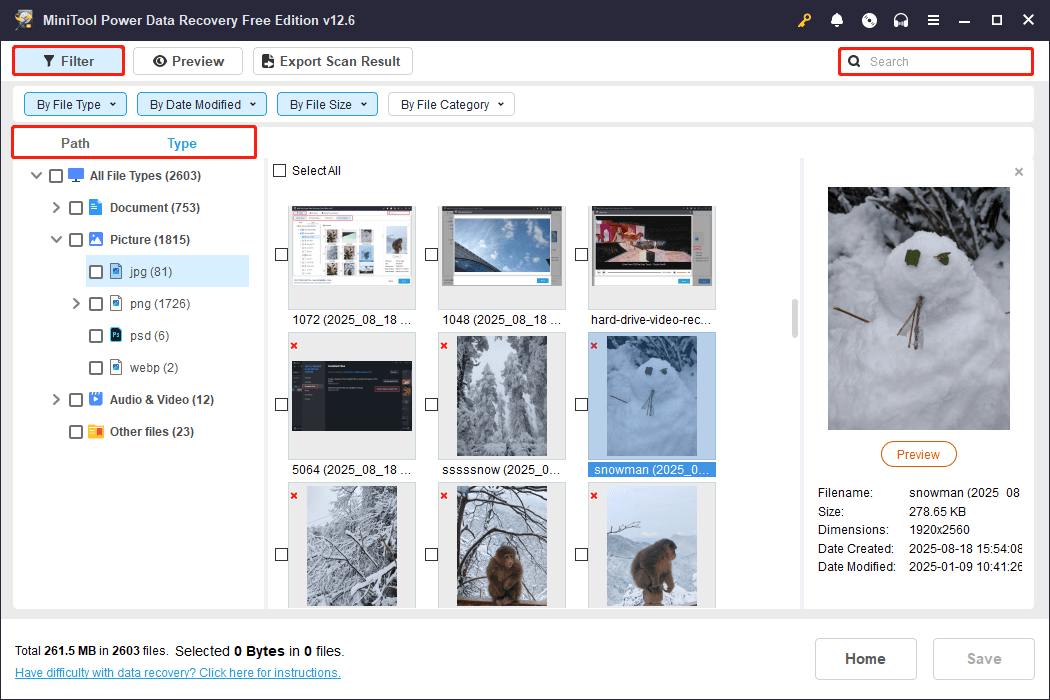
Besides, remember to preview the target files before recovery to check their contents and confirm they are the ones you need. To preview a file, simply double-click it.
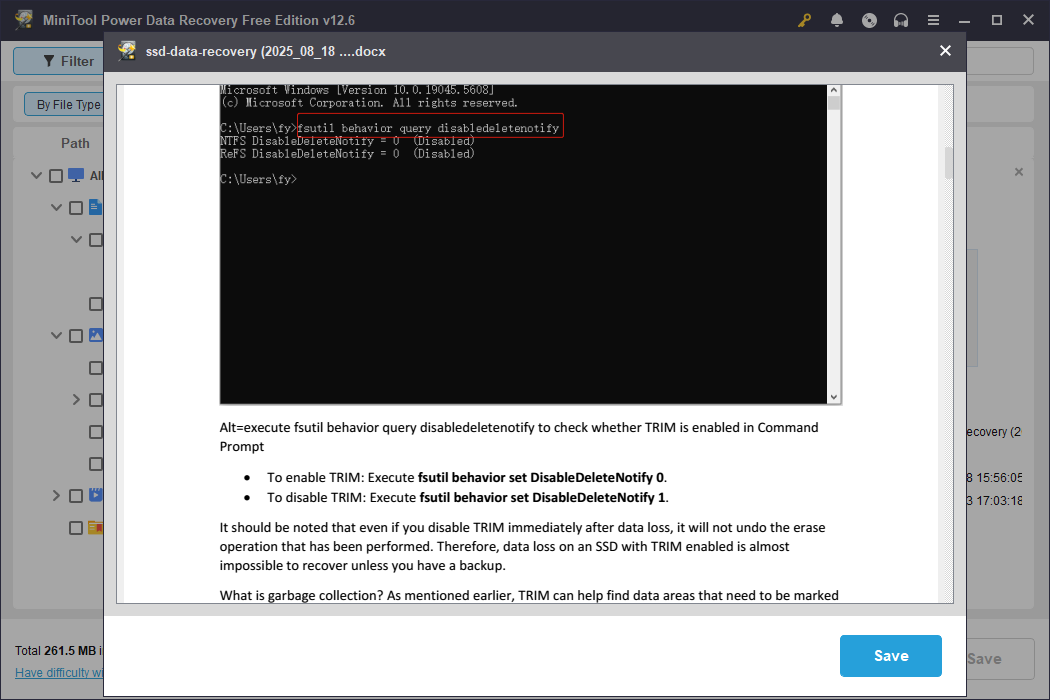
Step 3. Finally, review the selected files to ensure all wanted items are checked, then click Save and choose a safe location to store them.

Once done, your files are safe. Then you can format the disk to a valid file system for further use. Continue reading to learn how to format a hard drive.
Action 2. Format the Disk
When the “CHKDSK cannot open volume for direct access” error appears, you may find that you cannot format the disk using Disk Management or File Explorer.
In this situation, you can try using MiniTool Partition Wizard to format your drive. It allows you to format hard drives, USB drives, and SD cards completely for free.
Step 1. Download, install, and launch this free partition manager.
MiniTool Partition Wizard FreeClick to Download100%Clean & Safe
Step 2. Select the disk partition you want to format, and then click the Format Partition option from the left menu.

Step 3. In the new window, type a partition label, choose an available file system, and click OK.
Step 4. Review the formatting settings or changes. If everything is OK, click Apply to confirm.
Once done, you can go to File Explorer or Disk Management to check if the disk is recognized and accessible again.
Fix 4. Seek Professional Help
If even MiniTool Partition Wizard (or other disk managers) cannot detect or format the disk, the issue is likely beyond your ability to fix. In this case, you may need to seek professional help to repair the disk or recover the data.
Recommended: Back Up Hard Drive, USB Drive, or SD Card
Disk corruption or data loss can happen from time to time, even if you use a high-quality hard drive or have good disk usage habits. Therefore, keeping your files in multiple locations is very important.
For example, you can:
- Copy important files to an external hard drive.
- Upload important files to cloud storage. Most cloud services, such as Google Drive, OneDrive, etc., provide some free space and allow you to upgrade for more.
- Use MiniTool ShadowMaker (free for 30 days) or other professional Windows backup tools to back up files on a hard drive, SSD, USB flash drive, or SD card.
With these easy methods, if your disk is corrupted or files are lost, you can easily restore them from the backup.
Final Thoughts
In short, to fix the CHKDSK cannot open volume for direct access error on Windows 10/11, first try restarting your PC or using another device. If the problem still exists, run chkntfs /X to force release the disk or run CHKDSK in a clean boot. If all else fails, recover files and format the drive.
After recovering your files, it is best to save them in several locations to prevent data loss again.
For any questions about MiniTool products, the technical support team can provide timely and detailed assistance. Feel free to contact them at [email protected].
CHKDSK Cannot Open Volume for Direct Access FAQ
Step 1. Open Settings and navigate to Update & Security > Recovery. Under Advanced startup, click Restart now.
Step 2. Select Troubleshoot > Advanced options > Command Prompt.
Step 3. Now you can run CHKDSK.
Step 1. Hold the Shift key while clicking Restart from the Power menu.
Step 2. Navigate to Troubleshoot > Advanced options > Startup Settings > Restart.
Step 3. Press F5/5 to enter safe mode.
Step 4. Type cmd in Windows search. Right-click Command Prompt and choose Run as administrator. You can now run CHKDSK with administrative privileges.
Step 1. In Windows search, type Command Prompt. Then right-click it and choose Run as administrator.
Step 2. Type CHDSK [drive letter]: /f /r /x and press Enter (replace the [drive letter] section with the actual letter of your drive).
Step 1. Hold the Shift key while clicking Restart from the Power menu.
Step 2. Select Troubleshoot > Advanced options > Command Prompt.
Step 3. Run CHKDSK.
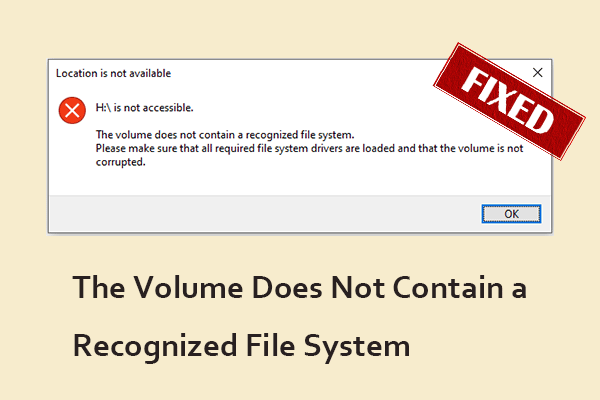


User Comments :